10 Business Studies 2
Section outline
-
Kia Ora and a very warm welcome everyone to Business Studies!
I am thrilled to have you all on board and look forward to working with you on all our challenges/tasks and projects.I am sure we will have a great time.
During our first week of meeting (in Week 2) we are going to get to know each other better and look at the course expectations.
Our learning outcome for this week is to be able to understand the outline for Business for this term.
Enjoy the first week back and remember to keep an open mind about new ideas (think outside the box)
-
Kia Ora Everyone
As we missed one session due to the public holiday, the focus this week is on Getting to know each other and introducing you to the outline for the Business Studies Option.
Team Building
Learning Intentions- Start to 'Form' our class as a team
- Build relationships (learn names, backgrounds, etc)
- Discover our Business 'prior knowledge'
- We have worked together to complete a task
- We found things that we have in common
- We know the meaning of common business terms
Activities:- Contribute to the shared Google Doc in Google Classroom called 'BUSINESS STUDIES INTRODUCTION"
- The doc asks you to add a photo of something that represents who you are as a person (eg you might be adventurous, home loving, or sporty).
- It asks you to give some information about yourself (a strength or skill that you're proud of, why you chose Business Studies, an embarrassing moment, etc.).
- The doc also presents some skills that you may have or need to develop.
- Think about what stage our class team is at - here's a simple resource on 'Stages of Team Formation'
- Please join the Google classroom page: Class code: f5oojql
- Start to 'Form' our class as a team
-
Kia Ora Everyone
This week we will be focusing on the concept of Business Studies & Entrepreneurship skills
Learning Intentions- What is Business Studies about?
- Understanding the key concepts in Business Studies in a NZ setting
- Exploring skills set for an Entrepreneur
- I understand the definition of Business Studies and it's link and impact to other areas/issues
- I understand the concepts linked to Business Studies
- We have identified skills set from our prior knowledge of a entrepreneur
Do Now - Entrepreneurs- Skills List - Brainstorm
- Exploring the Inspiring stories NZ website
- CETA Quiz
- Icebreakers (Building relationships)
Whole Class Activity- As a whole class, we'll watch the video "Caine's Arcade Part 1"
- Each small group choose a different attribute from the list of 6 above
- Create and share with me a Doc called "Entrepreneurs- Caine's arcade", type things that Caine says or does that shows that he has your chosen attribute?
Small Group Activity- As a whole class, we'll watch the video "Stupid ideas - Dragon's Den"
- In your small group, discuss whether you think Rupert Evans is an entrepreneur and which of the 6 attributes is he the weakest.
Homework- Watch the video Caine’s Arcade Part 2.
- In groups share whether you think Nirvan Mullick (Caine’s first customer) is an entrepreneur and explain why.
-
Kia Ora Everyone
This week we will continue focusing on Entrepreneurs by looking at their skills set and how you can apply these skills in a Business Studies setting.
Learning Intentions- Understanding the definition of an Entrepreneur and Introduction to Entrepreneurship
- Study case studies of entrepreneurial people
- Investigate characteristics of entrepreneurs.
- We can define an entrepreneur and describe the attributes of an entrepreneur
- We can identify people with entrepreneurial attributes and name examples of entrepreneurial people
- We have identified our own entrepreneurial strengths and areas to develop
Do Now - Entrepreneurship- DO NOW - Business Quiz (CETA)
Notes- https://www.businessnewsdaily.com/2642-entrepreneurship.html (Please read this article for homework if you have not finished this in class)
Entrepreneurs are innovative. They:
- Have ideas AND can put them into action
- Are creative problem solvers (think outside the box)
- Work long hours
- Can sell and / or build
- Can simplify processes and data - identify what's important
- Are effective with people
Activity:
- Group Task: If you and your group were to change something in the world, what would be and why? You have 1 and a half sessions to plan and half a session to present.
-
Kia Ora Everyone
This week we will continue focusing on Entrepreneurs by looking at their skills set and how you can apply these skills in a Business Studies setting.
Learning Intentions- Understanding the definition of an Entrepreneur and Introduction to Entrepreneurship
- Study case studies of entrepreneurial people
- Investigate characteristics of entrepreneurs.
- We can define an entrepreneur and describe the attributes of an entrepreneur
- We can identify people with entrepreneurial attributes and name examples of entrepreneurial people
- We have identified our own entrepreneurial strengths and areas to develop
Activity:
DO NOW: Read articles from your google classroom page. Identify the characteristics that each person possess from the respective articles.
- Group task - Identifying characteristics of contemporary entrepreneurs - slideshow activity
- Group Task: If you and your group were to change something in the world, what would be and why? You have 1 and a half sessions to plan and half a session to present.
- Group Task: Identify famous you-tubers - do you think that these you-tubers could be classified as an Entrepreneur.
-
Learning Intentions
- Understanding the definition of an Entrepreneur and Introduction to Entrepreneurship
- Study case studies of entrepreneurial people
- Investigate characteristics of entrepreneurs.
- We can define an entrepreneur and describe the attributes of an entrepreneur
- We can identify people with entrepreneurial attributes and name examples of entrepreneurial people
- We have identified our own entrepreneurial strengths and areas to develop
Activity:
- Reading articles on Entrepreneurs: Bloomberg, CNBC Make it, WEF
- Video and Articles: Successful Entrepreneur
- Pitching ideas for You tube (from last session)
- Team building activities
-
Learning Intentions
- Understanding Businesses and Business Structures
- Understanding the importance of teamwork
- We are understanding sectors and industries within NZ and out of NZ
- We understand the how businesses start and they function
Activity:
- Business introduction, industries, sectors - activity
- https://www.business.govt.nz/- Understanding Businesses and Business Structures
- https://www.business.govt.nz/getting-started/taking-the-first-steps/10-step-guide-to-starting-a-business/
- - Team building activities
-
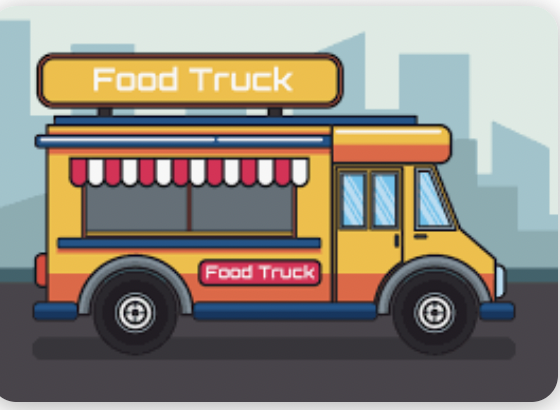
Learning Intentions
- Understanding how popular foodtrucks are as a business idea
- Learning key aspects when operating a food truck
- Understanding the challenges and advantages of a food truck vs a cafe or restaurant
Activity:
- Food Truck activity and presentation- - Team building activity
-
Learning Intentions
- Understanding Businesses and Business Structures
- Understanding the importance of teamwork
- We are understanding sectors and industries within NZ and out of NZ
- We understand the soperations and success of Maori buisnesses
Activity:
- https://www.business.govt.nz/- Understanding Businesses and Business Structures
- - https://www.nzherald.co.nz/kahu/why-the-maori-way-of-doing-the-business-actually-does-the-business/IFGKLRHOPVHJDLJXLBJZWDLIE4/
- - https://seniorsecondary.tki.org.nz/Social-sciences/Business-studies/Maori-business/Culture-and-values
- - After using the Tki link, research Maori Businesses and identify the values that they practice in their Business.Use the google doc to support you in completing your research.
-
Kia Ora Everyone
This week we will be focusing on the different types of Business structures
Learning Intentions
- We are understanding the different business structures
- We can explain the structure of business and its pros & cons
- We explored various examples of the business structure and understand the comparisons
Activities:- Identify various business that fall under the Business structures that you have studied. Look up Business that you are are familiar with and identify what Business structure they fall under
-
Learning Intentions
- Understanding Maori Businesses and steps to start a business
- We understand the step by step guide to opening a business and the success of Maori businesses
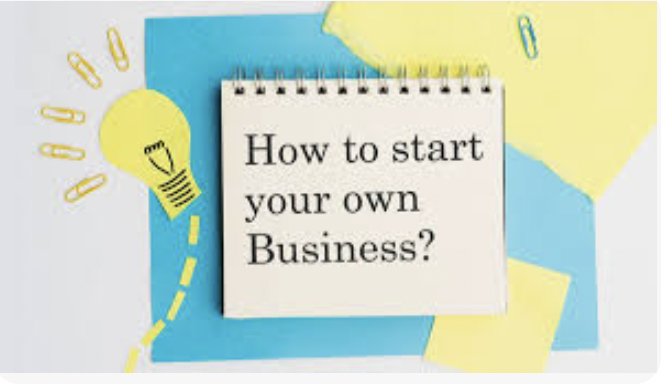
Activities:
Links for Business Start ups
https://www.shopify.com/nz/blog/how-to-start-a-business
https://www.business.govt.nz/getting-started/taking-the-first-steps/10-step-guide-to-starting-a-business/
Resources for Maori Business
- https://www.nzherald.co.nz/kahu/why-the-maori-way-of-doing-the-business-actually-does-the-business/IFGKLRHOPVHJDLJXLBJZWDLIE4/
- https://seniorsecondary.tki.org.nz/Social-sciences/Business-studies/Maori-business/Culture-and-values
- After using the Tki link, research Maori Businesses and identify the values that they practice in their Business.Use the google doc to support you in completing your research
-
- Markets & Segmentation

Learning Intentions- Study case studies of markets and marketing
- Investigate the nature of marketing: Plan, Strategy and Segmentation.
- We can define and explain Markets
- We can describe how & why markets are segmented
- We have added to the glossary of business terms
Markets- A Market is a way in which buyers and sellers exchange goods or services. It can be a physical marketplace like a bazaar or shopping centre, or a virtual, online market (eg share or money market, Trade Me, eBay). Resource on markets
- Maeklong Market in Thailand has hundreds of small vendors using identical stands with identical shade awnings, selling identical products. Many sell the same types of fresh fish, others the same types of vegetables, and others the same cooked food.
Do Now - Markets
- As a class we'll watch the video clip of the market. Discuss the following questions and then answer them individually in the Google Doc called Markets, Segmentation and Research:
- TASK ONE
- As a customer, why might you choose to buy from one stall, rather than others, when so much is identical?
- If you were a vendor in the market, would you be able to lower your prices? What might happen if you did?
- Would you be able to make your products appear to be, different? If so, how?
- How could, or how do, vendors promote their products?
- Are there ways vendors at the market might try to vary the place where they exchange their products with customers?
Market Segments

A Market Segment is a group of individuals with similar characteristics, eg Generation Z, retired couples, teenage girls, DINKYS.
For example, markets can be segmented by gender, age & life-cycle stage, socio-economics, ethnicity, lifestyle / family type, location, product use.
By segmenting the market, businesses can more accurately meet the needs of their target market. They can offer variations of their product that make the consumer think one variation is specifically designed for them and so they are willing to pay a higher price.
Do Now
Toothpaste is toothpaste, right? Wrong - at least, not in the Marketing Department. In small groups, discuss the different types of toothpaste available in the shops. This Countdown online shopping site might help. Individually answer the questions in the Google Doc called Markets, Segmentation and Research.
Marketing
Marketing follows a market oriented approach where businesses seek to identify customer wants, and future wants and then goes about trying to satisfy them profitably.
To do this they must first determine who the most likely users or consumers of their products or services are. This will allow them to identify the needs and wants of these consumers to ensure that their product is developed to meet these needs. The group identified is called the target market.
Market SegmentationTo help identify the target market, prospective customers are divided into groups (segments) that have common needs and wants. There are many ways to do this. Four common segments used by marketers are:
Possible Target Market for Ferrari F8 Tributo
Demographic
Age: Middle aged. This because the are most likely finished university etc and have been working for some time to accumulate enough wealth to purchase this car
Gender: Most likely male.
Socio Economic Status: High income.
Family life cycle: Single or retired, Children have grown up. Car is a two-door, so is not suitable for passengers apart from the owners partner or date.
Psychographic
Sporty. Likes car racing, speed etc. Possibly F1 fan as Ferrari races in F1.
Social status: Wealthy to be able to afford this car.
Personality: Wants people to know his social status, know that he is successful (rich).
Values & Attitudes: Wants something exclusive that not many other people have.
Geographic
Resides in a wealthy suburb
Large cities in well developed countries
Behavioural
Likes luxury. Happy to spend for high quality. Brand must be well known.
TASK: Using all four of the basic market segments above, identify the possible target market for the products below. Explain your answer by stating reasons for your suggestions.
Dove beauty soap
Barbie Doll
Revlon Lipstick
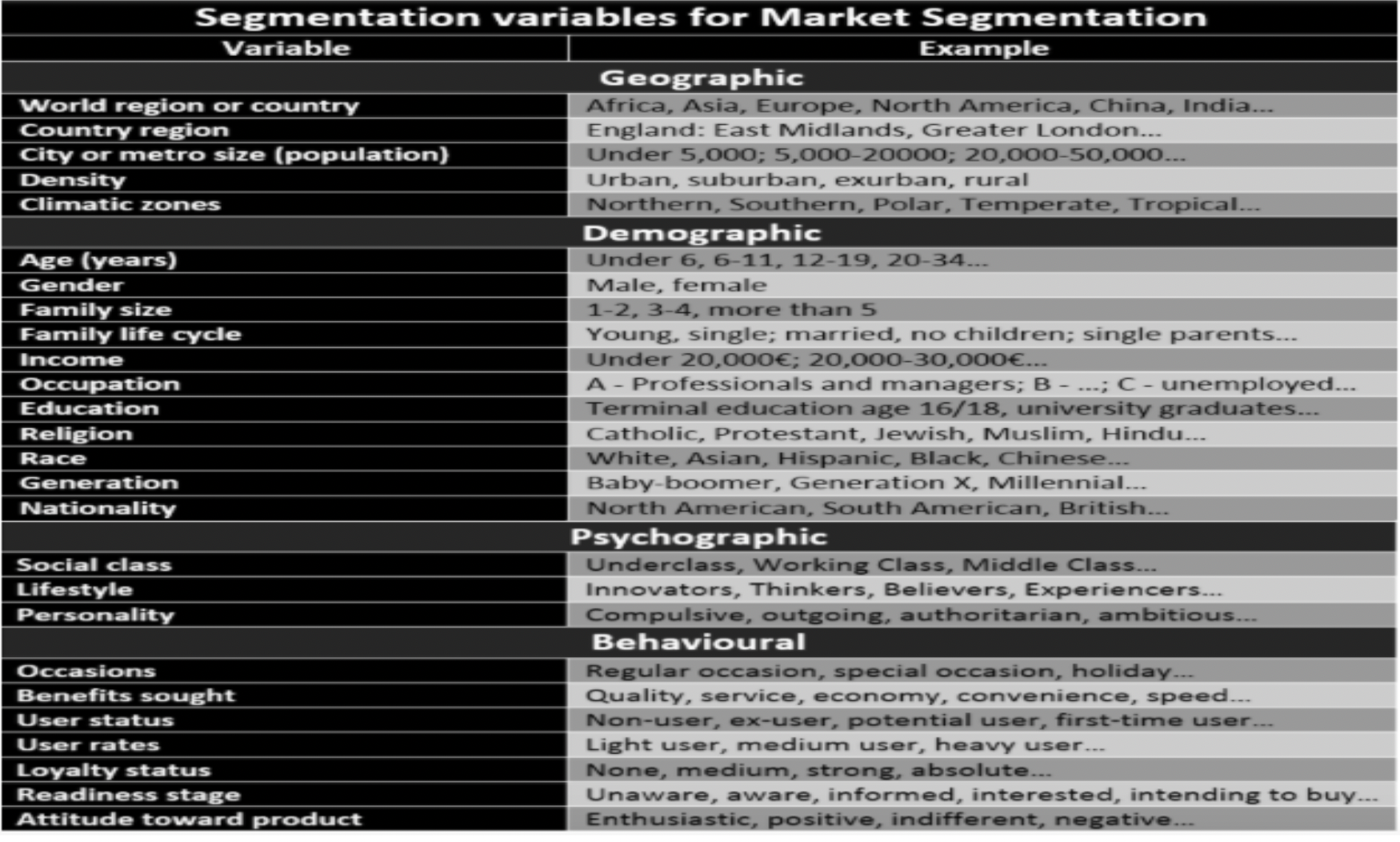
- Study case studies of markets and marketing
- Markets & Segmentation
-
Market Research
Learning Intentions
- Investigate the meaning and examples of research-related terms
- Explore how and why companies gather information on us as consumers
- Can define and explain, with examples, market research-related terms
- Am aware of how companies gather information about my buying habits.
Market research is defined as the process of gathering data on goods and services to determine whether the product or service will satisfy customers' needs.
To find out the needs and wants of their customers or consumers, businesses invest in market research to collect this information.
Types of information
Market research seeks to collect two basic types of data:
Quantitative: tells us “how many.” This data can be measured. It can measure how customers think, feel or act in regards to a particular product or service. For example how many people prefer coke to coke no sugar; How many people would be willing to pay a certain price for a product or service etc.
Qualitative: answers questions where an opinion or judgment is necessary. It helps businesses to know the 'why' or 'why not' in regards to their products and services. Qualitative research is important for gaining a broad understanding of the reasons and motivations behind consumer decisions. For example, asking consumers:
- What do you like about our product?
- What could we do to improve this product?
- Why wouldn't you buy this product?
Businesses use two types of data collection to gather this information
Primary Market ResearchThis is sometimes referred to as "field research." It involves the collection and collation of original data from potential or existing customers. Field research includes conducting;
- Questionnaires
- Interviews
- Consumer panels
- Focus Groups
- Observations
There are business that specialise directly in collecting primary market research for other businesses. Whether businesses conduct this research themselves or pay someone else to do this, it can be a costly and lengthy process. However, market research can identify market trends, demographics, psychographics, behavioural segments, economic shifts, customer's buying habits, and important information that may give it a competitive advantage. It can also help a business to know what type of products or services would be profitable to introduce in the market.
For existing products, it can help the business to know where to allocate its funds and resources efficiently. It enables a company to know if it has been able to satisfy customer needs and whether any changes need to be made in the development, packaging, advertising, delivery or the product itself.
Secondary Market ResearchThis is sometimes referred to as "desk research." It involves using information that has already been collected by other agencies or sources.
Can be from both internal (within the business itself) or external sources.

GROUP TASK:
In your groups, conduct some primary market research in our class to determine the possible success of a proposed new product for McDonalds. For example, a new burger, combo, sundae, drink OR any idea your group may have.
- Describe (in detail) your proposed target market for the new product
- Describe the actual product (ingredients etc.)
- Be sure to collect both quantitative and qualitative data.
- Summarise your results on a doc or slideshow to share your findings. According to your research, will this idea be successful?
- Facebook have just been threatened with a fine in Belgium for doing something to do with gathering data on people - describe what.
- Supermarkets and other shops have loyalty cards - explain why this is relevant to market research?
- Describe other ways that companies find out about your buying habits?
- Facebook loses privacy case, faces fine of up to $125,000 million
- 6 ways retailers track your spending habits
- Tracking customers will be the norm
- Technologies to track people
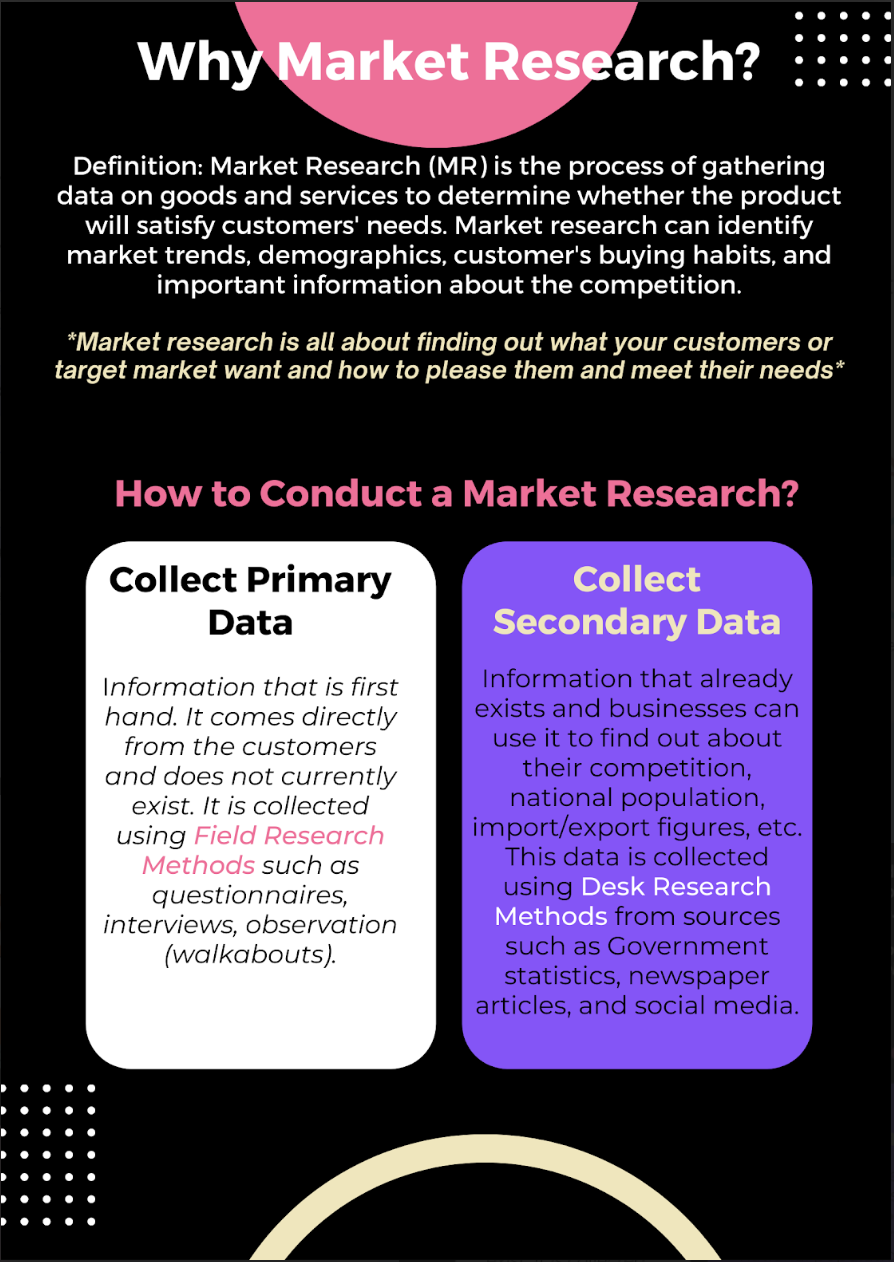
-
Learning Intentions
- Investigate the meaning and relevance of the Marketing Mix (4 Ps)
- Explore the 'Product' element of the Mix, through case studies and examples
- Can explain the meaning and relevance, with examples, of the Marketing Mix 4 Ps
- Can explain and apply understanding of the Product element of the Mix.
Marketing is the process of gathering information about people in the market and then acting on that information to influence their beliefs or decisions about your products or business.
The Marketing Mix contains the variables that can be changed in order to influence people's beliefs or decisions. In business, the aim is usually to attract customers to buy the product (to satisfy their needs or wants). These variables are called the 4Ps:- Product design features, quality, packaging, after-sales service, etc
- Price skimming, penetration, etc
- Place distribution channels, delivery, retail outlet, mail order, etc
- Promotion advertising, sales promotion, personal selling, publicity, etc
In small groups, discuss the 4Ps of these businesses or products:- Local Dairy shop
- Pack'n'Save supermarket vs Farro supermarket
- Apple computers and phones
- Nike shoes
- Homebrand product range (at Countdown supermarket)
Product
A product is a good (tangible) or a service (intangible) produced by an organisation. Companies can grow using existing or new products:
 Strategies for each method of growth
Strategies for each method of growthMarket penetration: encourage consumers to use more, 'steal' competitor's customers
Market Development: new uses for products, new markets geographically, new segments
Product development: modify existing products (eg new shapes), upgraded model, 'me-too' copycat product
Diversification: risky as you have less knowledge & experience (may buy an existing business).
Value Analysis
 Value analysis is the process of deciding which product features most attract or satisfy a target customer's needs.For example,
Value analysis is the process of deciding which product features most attract or satisfy a target customer's needs.For example,- Function will be most important when buying a parachute!
- Fashion clothes or bought mostly on the basis of aesthetics (how they look).
- Economic manufacture is important for customers who have low income
Product Life Cycle
 Sales, costs and profit of a product follow a series of stages over its life.
Sales, costs and profit of a product follow a series of stages over its life. When being developed, there are no sales, high costs and no profit - just losses.
A newly introduced product has slowly growing sales, high costs & no profit.
Sales increase rapidly during the Growth stage, unit costs start to fall and some profit may be made.
As competitors enter the market during Maturity, sales stop growing, costs reduce and profits are high.
When the market becomes saturated with too many businesses competing for customers, a price war can start and some businesses drop out. Costs remain constant, but sales and profits decrease.
The market declines and the product eventually becomes unprofitable.

Discussion: In small groups, discuss the range of life cycle diagrams on the right and think of examples of real products for each one.The life cycle is important because:
- each stage needs a different marketing mix
- a business needs products at different life stages to survive long term.
Extension strategies
Businesses try to extend products' lives beyond the saturation stage and so might repackage or slightly change it. Lux soap is more than 100 years old and its shape, perfume, colour, size and packaging have all changed to maintain consumer interest in it. Other extension strategies are finding new uses or accessories for the product. Examples of long lived products are Dettol, Bisto, Persil, Marmite, Coleman's mustard, Tetley tea.Life cycles are getting shorter as technological change accelerates. Products can become obsolete within months as more advanced versions are released.
Product portfolio

It helps to sustain your business to have a range of products at different stages of their life cycles, so that as sales of one decline, sales of others are growing.
In the product portfolio, some products may be cash cows, which are established brands in mature markets. The main work has been done. They sell well, bring money in, but are unlikely to increase sales. Every business wants these!
Stars are also great to have because, not only are they strong brands in the market, but also the market is growing and so income and profits will probably increase.
Dogs are products that are sold to the last, loyal, 'die hard' customers. They are not attracting new consumers and will probably be phased out.
Question marks are in a growing market and may become established, popular brands, but this is uncertain. Work is needed here to make them stars.
Obsolescence
 Obsolescence is the process by which products become disuded, discarded or 'overtaken' by more up-to-date versions or products (eg vinyl records, magnetic cassette-tapes, CDs, MP3 players).
Obsolescence is the process by which products become disuded, discarded or 'overtaken' by more up-to-date versions or products (eg vinyl records, magnetic cassette-tapes, CDs, MP3 players).
Built-in obsolescence results from the product's design or durability (ie how long before it wears out).
Planned obsolescence is making a product out of date by deliberately introducing a new version or product.
Discuss examples of products that became obsolete without their manufacturer's intention.
Discuss examples of products that are obsolete because their manufacturer deliberately released a new product.Discuss why obsolescence might benefit a company (eg Apple iPhones).
-
Learning Intentions
- Investigate the meaning and relevance of the Marketing Mix (4 Ps)
- Explore the 'Product' element of the Mix, through case studies and examples
- Can explain the meaning and relevance, with examples, of the Marketing Mix 4 Ps
- Can explain and apply understanding of the Product element of the Mix.
- Packagaging task on your google doc.
-
Learning Intentions
- Investigate the meaning and relevance of the Marketing Mix (4 Ps)
- Explore the 'Product' element of the Mix, through case studies and examples
- Can explain the meaning and relevance, with examples, of the Marketing Mix 4 Ps
- Can explain and apply understanding of the Product element of the Mix.
- Check doc on packaging (pair and share)
- USP Examples to complete - Class and homework. Homework examples are below: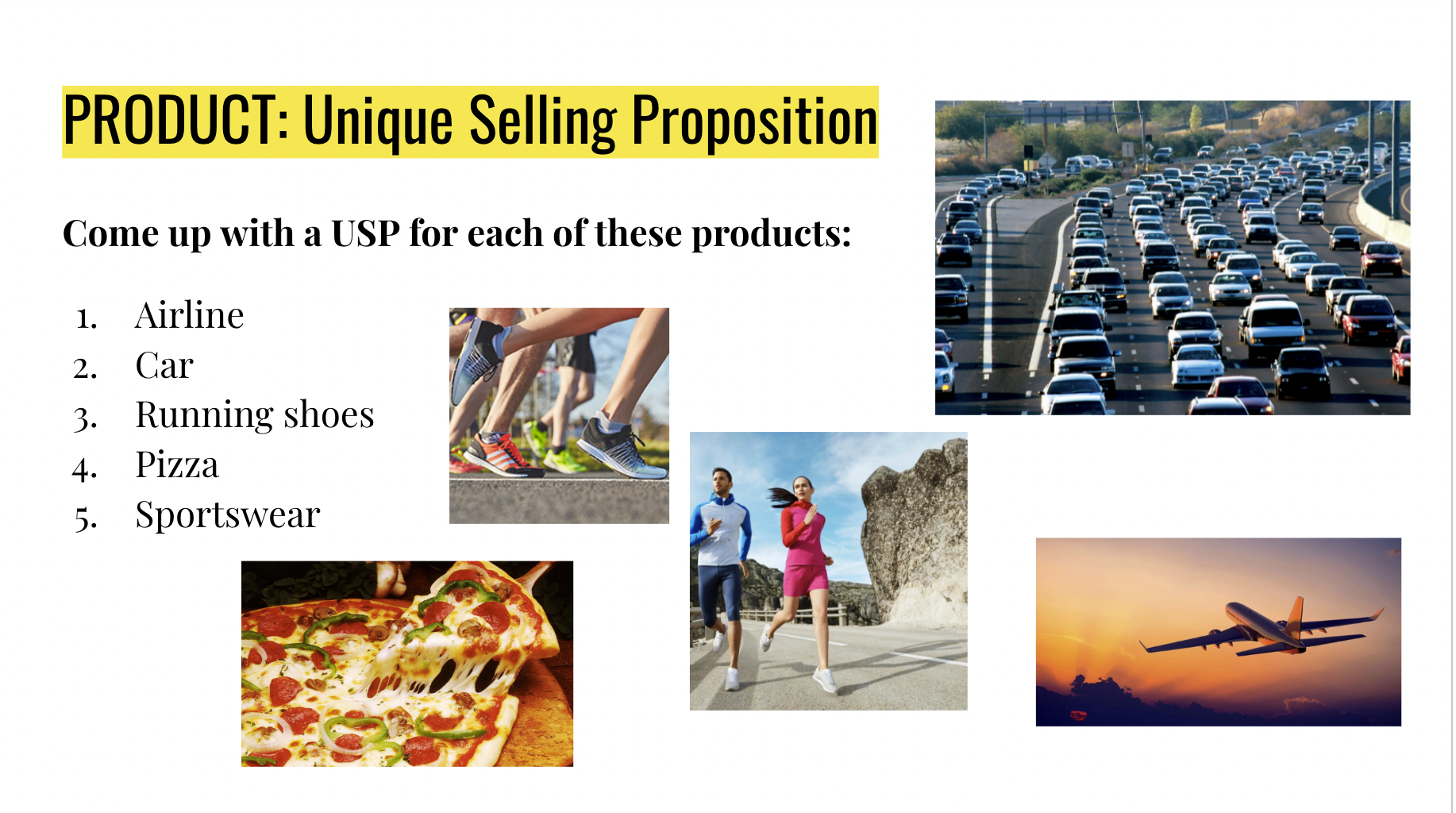
-
Learning Intentions
- Investigate the meaning and relevance of the Marketing Mix (4 Ps)
- Explore the 'Product' element of the Mix, through case studies and examples
- Can explain the meaning and relevance, with examples, of the Marketing Mix 4 Ps
- Can explain and apply understanding of the Product element of the Mix.
- USP Examples to check
- Product Life cycle - Class examples and discussion
- Answer questions for the first "P" (Product) of marketing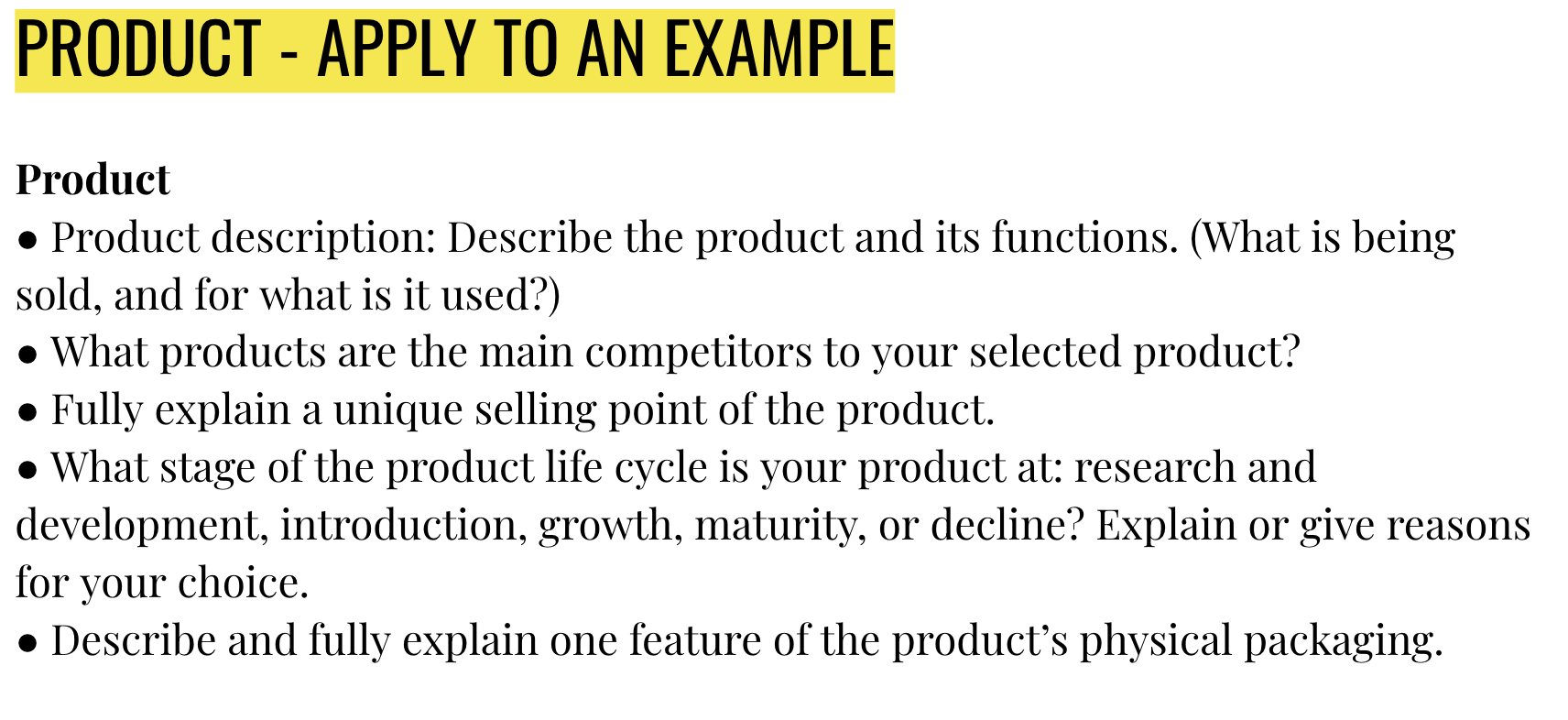
-
Learning Intentions
- Investigate the meaning and relevance of the Marketing Mix (4 Ps)
- Explore the 'Product' element of the Mix, through case studies and examples
- Can explain the meaning of promotion and the different promotional methods that will attract the respective target market
-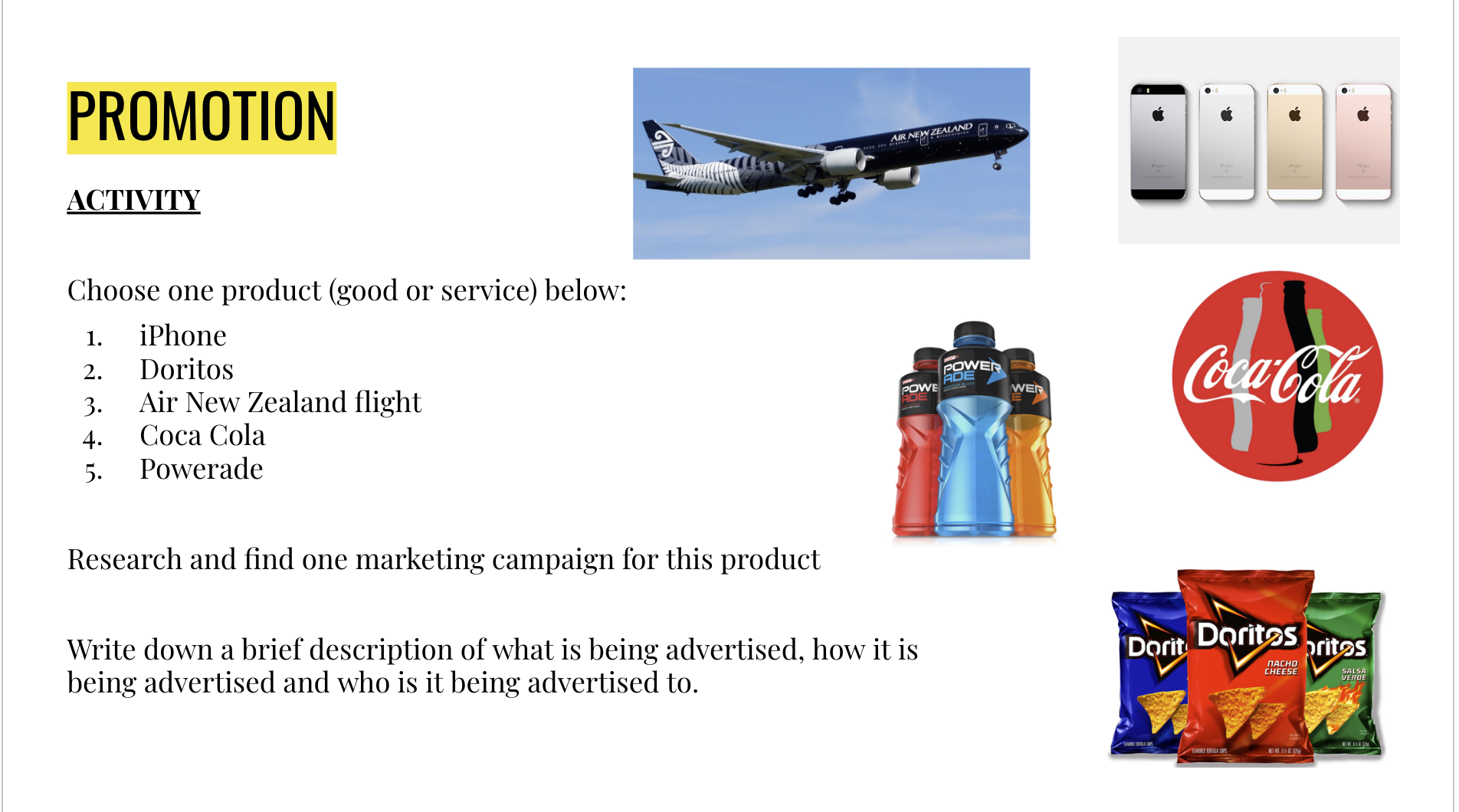
-
Learning Intentions
- Investigate the meaning and relevance of the Marketing Mix (4 Ps)
- Explore the 'Product' element of the Mix, through case studies and examples
- Can explain the meaning of promotion and the different promotional methods that will attract the respective target market
-
-
Learning Intentions
- Investigate the meaning and relevance of the Marketing Mix (4 Ps)
- Explore the 'Product' element of the Mix, through case studies and examples
- Can explain the meaning of promotion and the different promotional methods that will attract the respective target market
-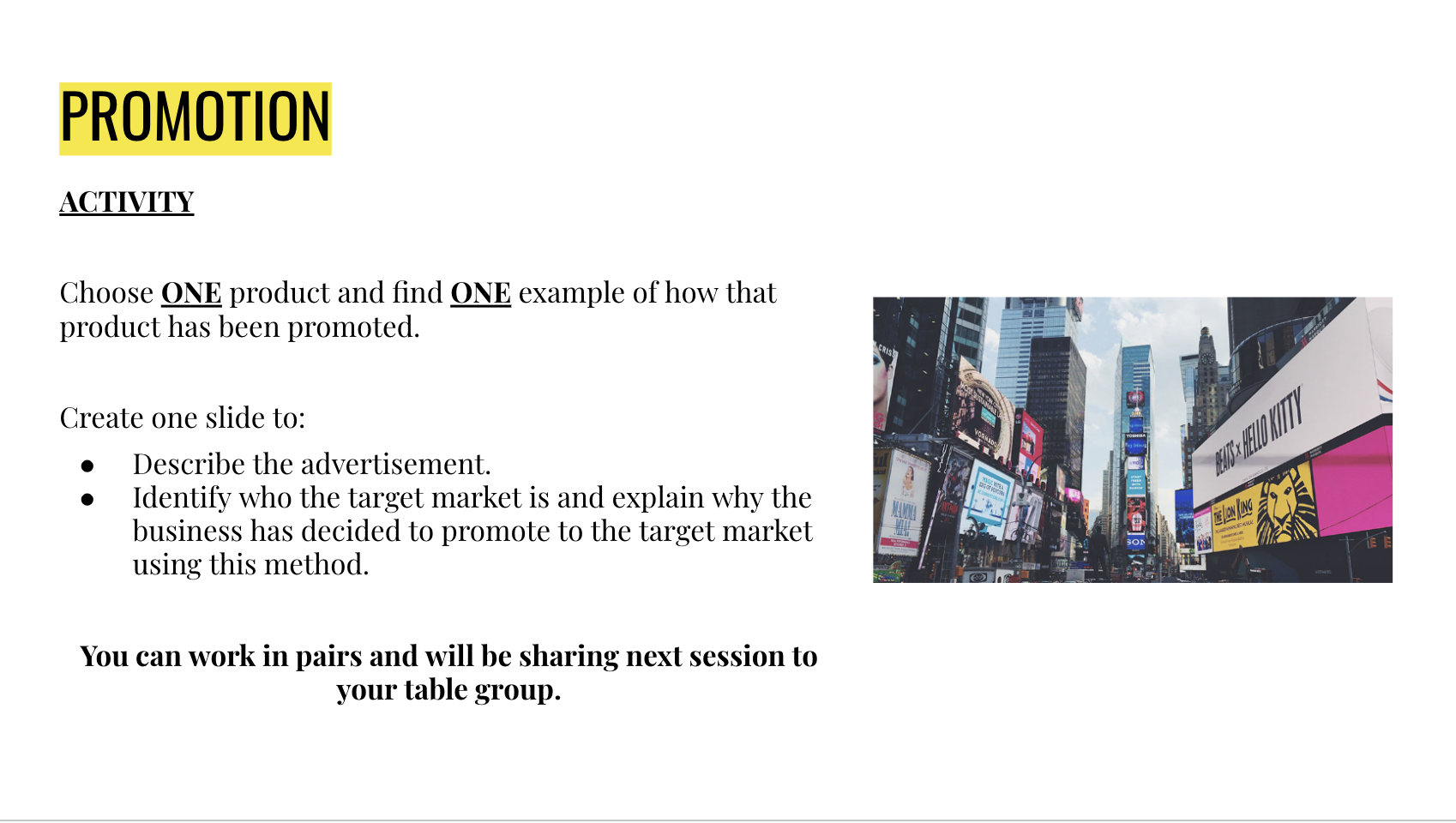
-
Learning Intentions

- Investigate ways in which businesses distribute their products to customers.
- Explore examples of different distribution channels and what affects business's choice of channel.
- Can describe several ways to distribute products and the factors that affect this choice.
- Can provide examples of different distribution channels.
Place
Distribution (Place) ensures products are available to customers in the right quantity at the right time in the right place. It involves questions like:
- Where do consumers prefer to buy the product?
- How can we ensure the product is available to existing and potential customers?
- How important are speed, timing, cost, availability
- How much stock should we hold? Too little and we run out; too much and we tie up cash (that then cannot be used to pay daily expenses)
It depends on:- The product - is it perishable, technically complex, a convenience item?
- The market - is it geographically spread out, highly competitive?
- The business - is It large, supplying producers or consumers?
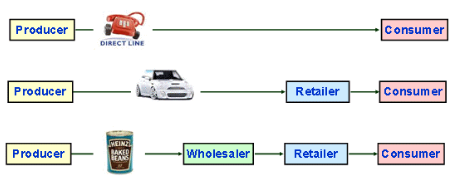 A distribution channel is the means by which the product moves from production to consumption. It might include:
A distribution channel is the means by which the product moves from production to consumption. It might include:- Retailer sells direct to households / end users / consumers
- Wholesaler sells products from different manufacturers to retailers; they 'break bulk' by putting large quantities into smaller packages
- Distributor have a contract to sell a manufacturer's products
- Agent a 'go-between' who never owns the product and earns commission eg real estate, insurance, travel.
- Franchisee allowed to trade under the the manufacturer's name; pays a fee and gives a share of the revenue to the franchisor
- Direct selling door to door, mail order, sales reps
Trends in distribution are:

- more out of town stores and malls (in Europe, malls are closing);
- fewer independent and more multiple / chain retailers;
- more franchises (eg Jim's mowing);
- online shopping and home delivery.
- drone and driverless delivery??
Extension activities (Optional)
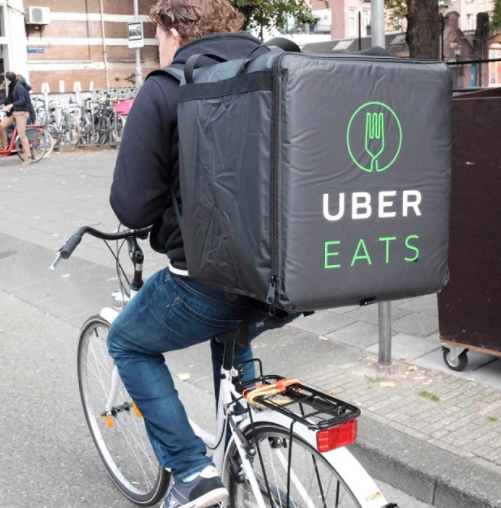 Research the service that Uber Eats provides.
Research the service that Uber Eats provides.
Consider the impact on distribution of restaurant food.
How do restaurants and householders benefit?
Watch this video clip on drone delivery and discuss the impact on distribution channels and on different organisations that might be affected.
Watch this video clip on 3D printing and and discuss the impact on distribution channels and on different organisations that might be affected.

-
Learning Intentions
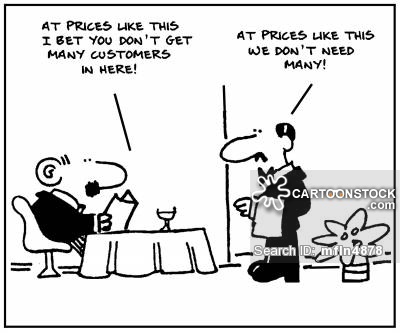
- Investigate ways in which businesses can price their products
- Explore examples of different pricing strategies and reasons for using each strategy.
- Explore the specific effect of changes in price on quantity sold and thus on profit.
- Can describe several key strategies for pricing products
- Can predict the effect of a price change on sales and thus profits.
Price
The price of o product sends strong messages to consumers. Would you buy a parachute in a sale at half price, or a perfume, for a valued friend, that was advertised as being low price, or petrol at a much higher price than competitors' prices?
Pricing strategies
- Cost-plus pricing - adding a percentage markup to the estimated unit cost.
- Penetration pricing - initial low price to encourage customers to try the product (but could send the message of low quality).
- Skimming - high price until competition forces it down
- Competitive pricing - in line with, or a certain percentage above, competitors' prices.
- Psychological pricing - appears closer to customer's perceived value (eg $3.99)
- Prestige price - to promote a luxury image (eg perfume)
- Price discrimination - price for the same product varies for different customer groups (eg students, off-peak travel).
- Loss leader - very low price attracts customers into the shop to buy other products at 'normal' prices.
- Promotional pricing - low price for a short time to renew customer interest or clear unwanted stock.
- Range pricing - prices of similar types of product kept within limits.
In your group, discuss which price strategy is being used in each of the examples below:
- A watch that’s very similar to others sold in the shops
- A toy sold for $1.95
- A tour operator sells holidays during the school holidays as well as at other times.
- A new brand of washing powder is launched - there are several similar ones already available
- A supermarket wants to cover the cost of vegetables and make a 100% profit as well.
- A new mobile phone has been developed that has extra features compared to the competition
Pricing Strategies
Cost-Plus Pricing
The business takes into account the cost of manufacturing the product and then adds on a profit mark-up. This can either simply cover costs or include an element of profit. It focuses on the product itself and does not take into account consumers’ expectations or perceptions. It is very easy to apply but the business may lose sales if their price is more than competitors.
Penetration Pricing
This is where the business sets the price lower than the competition to ‘penetrate the market.’ This is often useful when launching into a new or highly competitive market. It is typically used with mass market products – chocolate bars, food stuffs, household goods, etc. It is also suitable for products with long anticipated product life cycles.
Other benefits:
- Market share is quickly won.
- Encourages consumers to develop a habit of buying
- ‘Low’ price to secure high volumes
Price Skimming Strategy
This is where the business sets an initial high price for a unique product encouraging those who want to be ‘first to buy’ to pay a premium price. Later in the products life cycle they may then lower the price. It is usually used alongside a promotional campaign to create high demand for the new product before it is even launched. This strategy helps a business to gain maximum revenue before a competitor's product reaches the market. This is often used with technology products like mobile phones and devices.
Loss Leaders
This is where chosen goods/services are deliberately sold below cost to encourage sales elsewhere in the business. The business hopes that the purchases of other items more than covers ‘loss’ on item sold. It is typically used in supermarkets, e.g. at Christmas, selling bottles of coke at $0.99 in the hope that people will be attracted to the store and buy other products as well that will cover the loss made on the coke. Cell phones & contracts are another example.
Psychological Pricing.
This when particular attention is paid to the effect that the price of a product will have upon the consumers perceptions of the product. It may involve charging a very high price for a high quality product so that high income customers may wish to purchase it as a status symbol. E.g. Ferrari. Alternatively, it may charge a more reasonable or lower price so that consumers perceive it as an ‘affordable’, ‘value for money’ product.
 Another example of psychological pricing is selling products for $199 instead of $200 is also an example of psychological pricing as it creates the impression of being much cheaper.
Another example of psychological pricing is selling products for $199 instead of $200 is also an example of psychological pricing as it creates the impression of being much cheaper.Promotional Pricing
This is when products might be sold “on sale” or at a lower price for a short period of time. It includes “buy 1 and get 1 free” deals. It is useful for getting rid of unwanted stock. It could help renew interest in a business if sales are falling. The challenge for businesses is that the lower price also reduces sales revenue and profits.

-
Learning Intentions

- Investigate ways in which businesses can price their products
- Explore examples of different pricing strategies and reasons for using each strategy.
- Explore the specific effect of changes in price on quantity sold and thus on profit.
- Can describe several key strategies for pricing products
- Can predict the effect of a price change on sales and thus profits.
Price
The price of o product sends strong messages to consumers. Would you buy a parachute in a sale at half price, or a perfume, for a valued friend, that was advertised as being low price, or petrol at a much higher price than competitors' prices?
Pricing strategies
- Cost-plus pricing - adding a percentage markup to the estimated unit cost.
- Penetration pricing - initial low price to encourage customers to try the product (but could send the message of low quality).
- Skimming - high price until competition forces it down
- Competitive pricing - in line with, or a certain percentage above, competitors' prices.
- Psychological pricing - appears closer to customer's perceived value (eg $3.99)
- Prestige price - to promote a luxury image (eg perfume)
- Price discrimination - price for the same product varies for different customer groups (eg students, off-peak travel).
- Loss leader - very low price attracts customers into the shop to buy other products at 'normal' prices.
- Promotional pricing - low price for a short time to renew customer interest or clear unwanted stock.
- Range pricing - prices of similar types of product kept within limits.
In your group, discuss which price strategy is being used in each of the examples below:
- A watch that’s very similar to others sold in the shops
- A toy sold for $1.95
- A tour operator sells holidays during the school holidays as well as at other times.
- A new brand of washing powder is launched - there are several similar ones already available
- A supermarket wants to cover the cost of vegetables and make a 100% profit as well.
- A new mobile phone has been developed that has extra features compared to the competition
-
Learning Intentions
- To apply what we've learned in class to a real life product
- To experience an NCEA Level 1 assessment (and hopefully gain 3 credits at Excellence)
- To follow and complete the MHJC assessment using the set criteria
- Understand the importance of structured writing using (SEXY/PEDAL/PEEL/TEXAS paragraphs) and can write these.
- Have applied the marketing mix to my chosen product
- Have read the student instructions and mind-mapped my draft report.
- Understand what I need to do for Achieved, Merit & Excellence grades
- Have started the draft final report
Activities:
- Read through ALL materials on MHOL, Google classroom, your notes, TKI and student instruction.
- Checkpoint 1: Research file completed (by 3 August 2023)
- Checkpoint 2: Final report due using information from the research file evidence (9 August)
-
Kia Ora
This week, you will take your knowledge of the marketing mix and apply these principles to participate, plan a market day.
Learning Intentions
- Recognise the importance of market research for a business and how to conduct a market research for a new or existing product.
- Interpret market research data.
Success Criteria
- Conduct Market research for products planned for the upcoming market day.
- Analyse data collected from market research
Activities:
- Understanding the market day template
- Organising groups and begin brainstorm
-
Learning Intentions
- Recognise the importance of market research for a business and how to conduct a market research for a new or existing product.
- Interpret market research data.
Success Criteria
- Conduct Market research for products planned for the upcoming market day.
- Analyse data collected from market research
Activities:
Monday
- Drafting and finalising the google forms
- Checking the google form by Mrs Selagan
- Choosing classes to send the google form
- Understanding the market day template - Assessment 2
- Wednesday - Analyse the data
-
Learning Intentions/ Mo te ako
- Apply product costing formula.
- Calculate Market Day product prices.
- Understand the importance of business planning and business objectives.
Success Criteria
- Apply product pricing formula to determine product prices.
- Produce a list of retail price for Market Day products.
- Write smart objectives for planning for a the small business you have already created to participate in the market day.
Learning Activities
- Using cards and price strategies to cost market day product
-
Learning Intentions/ Mo te ako
- Identify and develop the main immediate purpose and the long term goal of your business.
- Identify business strengths and weaknesses, and anticipate opportunities and threats to your business.
- Understand branding principles through small business case studies
Success Criteria
- Write a business mission (purpose) and vision (aim) statements (including a slogan where necessary).
Write a detailed SWOT analysis for your business presented as a grid or a graphic.
Design a business brand kit including: Business name, logo, and brand colour
Learning Activities
- Completing SWOT (20 MIN) from the market day plan
- Looking at branding and promotion (25 - 30 min)
-
Kia Ora Everyone
Learning Intentions: We are learning to (WALT)...
Finalise our products in preparation for Market Day
Finalise our signage for market day
Success Criteria: I can/have...
Using the P's of marketing I can apply these concepts this when producing my product
Activities:
-Use the checklist on google classroom to determine if you are ready or not.
-
Kia Ora Everyone
Learning Intentions: We are learning to (WALT)...
Use our checklist in preparation for Market Day
Success Criteria: I can/have...
Using the P's of marketing I can apply these concepts this when producing my product
Activities:
-Use the checklist
- Waste free school and other reminders
- Float -money boxes/ Equipment
-
Kia Ora Everyone
Learning Intentions: We are learning to (WALT)...
Reflect on our market day
Success Criteria: I can/have...
Complete Assessment 2 by referring to the criteria
Activities:
-Refer to the rubric
- Complete market day evaluation form and check assessment - submit by 13 Oct
- Savy workshop - 11 October
-
Kia Ora Everyone
Learning Intentions: We are learning to (WALT)...
Understand basic financial literacy
Success Criteria: I can/have...
Use these basic financial skills in the near future eg: part time job
Activities:
-EP Tasks
- Complete market day evaluation form and check assessment - submit by 16 Oct
- Savy workshop - 18 October
-
Kia Ora Everyone
This week you will be presenting your ideas in your groups
Learning Intentions: We are learning to (WALT)...
Find Solutions/ideas to a case study
Success Criteria: I can/have...
Developed positive partnerships by collaborating in my group
Used my critical thinking and literacy skills to understand and unpack the text/case study.
Activities:
1. CETA Quiz
2. Case Study
3. Tax in schools
-
Kia Ora Everyone
This week you will be presenting your ideas in your groups
Learning Intentions: We are learning to (WALT)...
Find Solutions/ideas to a case study
Success Criteria: I can/have...
Developed positive partnerships by collaborating in my group
Used my critical thinking and literacy skills to understand and unpack the text/case study.
Activities:
1. CETA Quiz
2. Case Study/Shark Tank
-
Kia Ora Everyone
This week you will be presenting your ideas in your groups
Learning Intentions: We are learning to (WALT)...
Find Solutions/ideas to a case study
Success Criteria: I can/have...
Developed positive partnerships by collaborating in my group
Used my critical thinking and literacy skills to understand and unpack the text/case study.
Activities:
1. CETA Quiz
2. Case Study/Shark Tank
-
Kia Ora Everyone
This week you will be presenting your ideas in your groups
Learning Intentions: We are learning to (WALT)...
Find Solutions/ideas to a case study
Success Criteria: I can/have...
Developed positive partnerships by collaborating in my group
Used my critical thinking and literacy skills to understand and unpack the text/case study.
Activities:
2. Case Study/Shark Tank collaboration task
-
Kia Ora Everyone
This week we looking through the final activity before you present in week 8
Learning Intentions: We are learning to (WALT)...
Find Solutions to a problem
Success Criteria: I can/have...
Developed positive partnerships by collaborating in my group
Used my critical thinking and literacy skills to understand and unpack the problem.
Activities:
Shark Tank: Activity 3
Tax in schools programme
-
Work experience
-
Kia Ora Everyone
This week you will present your final idea.
Learning Intentions: We are learning to (WALT)...
Find Solutions to a problem
Success Criteria: I can/have...
Developed positive partnerships by collaborating in my group
Used my critical thinking and literacy skills to understand and unpack the problem.
Activities:
Presenting the final idea


